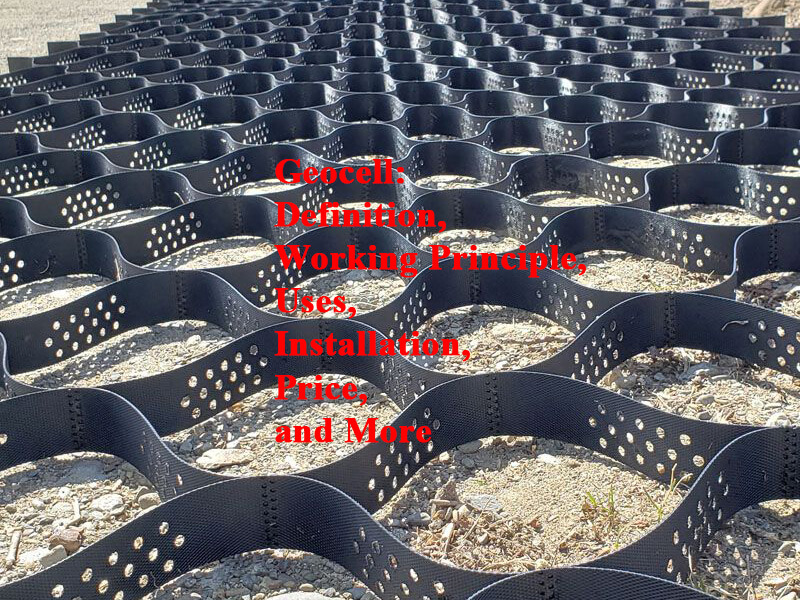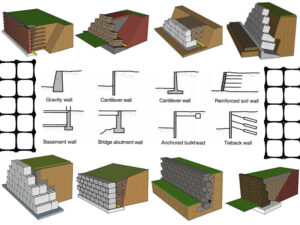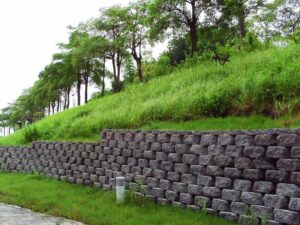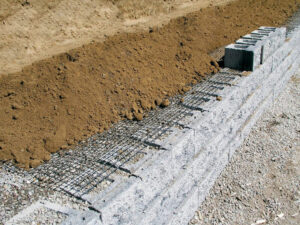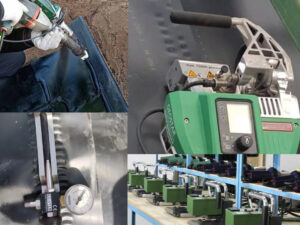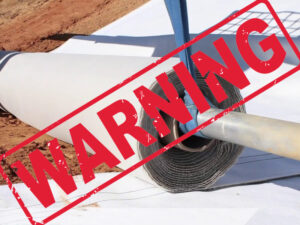Geocells, renowned for their exceptional cost-effectiveness, are extensively utilized in various engineering projects such as road construction and slope protection. Are you seeking information on its definition, working principle, applications, installation, pricing, and other aspects? In this article, QIVOC will provide a detailed exploration of the following aspects of geocell. You can click on the subheadings to navigate to the relevant content.
Table of Contents
What Is Geocell?
Geocell, also known as a cellular confinement system, is a three-dimensional grid structure made of high-density polyethylene or polypropylene and formed by high-strength welding. As a result, this structure exhibits powerful reinforcement capabilities during project construction.
The construction of geocells involves using geocell systems to create stable structures for stabilizing soil, controlling erosion, and protecting slopes. In the construction of various types of geocells, this honeycomb-like three-dimensional confinement system can be filled with soil, gravel, or other materials to enhance its load-bearing capacity. This method is particularly effective in areas where soil conditions are fragile or unstable.
Geocell reinforcement refers to the process of using this honeycomb confinement system to reinforce and stabilize soil in various engineering projects. By placing these interconnected grids on the surface of the soil and then filling them with soil, gravel, or other materials, a stable and reinforced structure is formed.
For instance, geocell reinforcement is employed in projects such as reinforcing highway and railway embankments, strengthening river embankments, and fortifying hybrid retaining walls, among others.
How Does Geocell Work?
The fundamental principle of geocells lies in their honeycomb-like three-dimensional confinement system, which significantly enhances the performance of common fill materials in load-bearing and erosion control applications over larger areas. The three-dimensional confinement refers to concentrating deformation within a three-dimensional space, leveraging the flexible structural characteristics of geocells to withstand external loads and resulting deformations.
For Example
When trucks travel on soft surfaces like sandy or dirt roads, they create deep ruts, with the tire tracks deeply sunken and the areas between them raised.
If vehicles continue to traverse the road, following the same path as previous vehicles, the sunken parts will sink further while the raised parts will become even more pronounced. Eventually, the raised parts may reach the undercarriage of vehicles, causing the wheels stuck in the sand, rendering them unable to turn, and possibly even causing the entire vehicle to become stuck or partially buried in the sand.
Why does the above result occur?
The result described above occurs due to the principles of mechanics. Under the influence of concentrated loads, the active zone of the foundation experiences compression and sinking, redistributing the force to the sides, which then transfers to the transition zone and subsequently to the passive zone. As a result, the soil in the passive zone easily deforms and protrudes under the force.
Then, if geocells are added to this part of the road, under the action of external loads, the active zone will still transmit the external force to the transition zone after being stressed. However, due to the limitations of the side walls of the geocell and the lateral resistance formed by the reaction force between adjacent geocells, and the friction between the geocell wall and the filler, the lateral movement of the passive zone and the transition zone is restricted. The result is that the bearing capacity of the roadbed is improved.
This also illustrates that by increasing the overall shear strength of the roadbed material or restricting the movement of the active, transition, and passive zones with the geocells, the bearing capacity of the foundation can be effectively enhanced. This is the fundamental working principle of geocells.
What Are Geocells Used For?
Geocells have diverse applications and can be used as cushion layers, for treating weak foundations, enhancing bearing capacity, forming slope protection structures, and constructing support structures.
Their primary application areas include:
- Reinforcing railway and roadbeds on soft ground.
- Strengthening foundations to support heavy embankments and retaining walls.
- Enhancing support structures for pipelines and sewers.
- Preventing debris flows and reinforcing mixed barriers with increased bearing capacity.
- Reinforcing standalone walls, docks, embankments, and more.
- Preventing soil erosion in deserts, beaches, river channels, and riverbanks.
- Handling semi-filled and semi-excavated roadbeds, reinforcing roadbeds in windy and sandy areas, reinforcing the base soil of embankment roads, reinforcing roadbeds in permafrost areas, reinforcing roadbeds in collapsible loess areas, and reducing pavement cracking.
In addition to various large-scale engineering projects, geocells can also be used for yard renovations.
For instance, those aiming to create modern and eco-friendly lawn driveways can utilize geocells for construction. In gardens, the use of geocells helps reduce soil erosion and enhances erosion control. They can also be employed in constructing flexible retaining wall systems, such as green walls with nearly vertical surfaces, allowing for rapid on-site construction.
How To Install Geocell?
The installation of geocell ground grid is a crucial step in engineering projects. The process primarily involves preparatory work, material inspection before laying, installation methods, quality testing, and considerations.
1. Preparation
Before commencing the installation of the geocell ground grid, thorough preparation is necessary. Firstly, the construction site needs to be cleaned to ensure a smooth surface without debris or standing water, facilitating the laying process. Additionally, it’s essential to inspect the quantity and quality of the geocell materials to ensure they meet the project requirements. Furthermore, based on construction drawings and on-site conditions, a suitable laying plan should be determined.
2. Material Inspection Before Laying
Before laying, it’s crucial to inspect the geocell materials to ensure their quality meets the standards. Specifically, the tensile strength, elongation rate, puncture strength, and other indicators of the geocell materials should be checked to verify compliance with design requirements. Additionally, the appearance quality of the materials, such as the absence of damage or holes, should be examined. Any materials found to be non-compliant should be promptly replaced or repaired to ensure construction quality.
3. Laying Method
3.1 Setting Out and Line Marking Before Laying
Before laying the geocell, setting out and line marking are essential steps. Based on the construction drawings and on-site conditions, determine the scope and spacing for laying the geocell. Accurately mark the layout on the construction site to provide guidance for the subsequent laying work.
3.2 Unfolding the Geocell
After the line marking is completed, unfold the geocell and lay it flat in the designated position. Pay attention to maintaining the flatness and straightness of the geocell, avoiding distortion or wrinkles. Also, adjust the length and width of the geocell according to actual conditions to meet design requirements.
3.3 Fixing the Geocell
After unfolding the geocell ground grid, it needs to be secured. Typically, anchoring pins or ballast are used to fix the geocell. During the fixing process, ensure that the positioning and quantity of anchoring pins or ballast are accurate enough to guarantee the stability of the geocell. Additionally, take care to protect the geocell material from damage or scratches.
3.4 Connecting the Geocell
Once the geocell is fixed in place, it needs to be connected. Professional fasteners are commonly used for this purpose. During the connection process, ensure that the connection points are flat and straight, avoiding distortion or wrinkles. Also, ensure that the strength of the connections meets design requirements to maintain the overall structural stability.
3.5 Quality Testing and Acceptance
After the laying is completed, quality testing and acceptance are necessary. Specifically, check whether the laying scope, spacing, fixing method, and connection method of the geocell meet design requirements. Additionally, conduct stability testing on the overall structure of the geocell to ensure it meets engineering requirements. Promptly rectify or rework any non-compliant areas to ensure construction quality meets standards.
4. Considerations
During the construction process, it’s essential to observe the following points:
- Adhere strictly to design requirements to ensure that the geocell’s laying scope, spacing, fixing method, and connection method comply with standards.
- Take care to protect geocell materials during construction to avoid damage or scratches. Additionally, maintain cleanliness and safety at the construction site.
- During quality testing and acceptance, conduct thorough inspections without omission or error. Promptly rectify or rework any non-compliant areas to ensure construction quality meets standards.
- Environmental protection and resource conservation should be prioritized during construction. Dispose of discarded geocell materials responsibly, considering options for reuse or recycling. Furthermore, optimize resource utilization to minimize energy and resource consumption.
Where to Buy Geocell And Geocell Price
Geocell is a product whose price is calculated based on the area. Generally, the price of geocell varies due to specifications, materials, manufacturing processes, and manufacturers. Taking QIVOC as an example, our geocell prices range from $0.12 to $6.32, and they differ depending on the height, thickness, and welding spacing of the product. For detailed price information, please email us for inquiries.
Now, purchasing Geocell is very simple and convenient. It can mainly be done through the following three methods:
1. Direct Purchases from Manufacturers
You can find suitable manufacturers by searching “geocell manufacturers” on Google. Alternatively, you can directly search for our brand, QIVOC, to contact us for purchases.
However,
If you are an individual buyer and purchasing in small quantities, it may not be suitable to buy from manufacturers (as many have a minimum order requirement of at least 5000 square meters). But you can purchase geocell from us (QIVOC). We provide high-quality and cost-effective geocells, along with free engineering solutions and after-sales guidance. Moreover, we have no minimum order requirement, so regardless of the quantity you need, you can receive our meticulous service and support.
2. Purchase on Platforms such as Amazon, Alibaba, eBay, etc.
You can also purchase geocell on platforms like Amazon, Alibaba, eBay, etc. However, geocell sold on these platforms may be slightly more expensive. This option is more suitable for individual buyers purchasing small quantities.
3. Purchase from Local Distributors or Manufacturers
Geocell is a common engineering material, so you can easily purchase it locally. Even if you are unsure of where to find stores selling geocells, you can search “geocell near me” on Google to find nearby distributors or manufacturers.
4. Purchase Geocell from Us (QIVOC)
Finally, we recommend purchasing geocell from us (QIVOC). We provide high-quality and cost-effective geocells, along with free engineering solutions and after-sales guidance. Additionally, we have no minimum order requirement, so you can receive our meticulous service and support regardless of the quantity you need.
What is the Difference Between Geogrid and Geocell?
Geogrids and geocells are both innovative building materials widely used in engineering projects such as roadbeds and slope protection. They are made by compressing polymer materials into a mesh-like structure, serving as geotechnical materials. They share similar characteristics in terms of compressive strength, load-bearing capacity, deformation, corrosion resistance, frictional resistance, and lifespan.
However, there are also many differences between geogrids and geocells.
1. Different Manufacturing Methods
The fundamental difference between the two lies in their manufacturing methods. Both geogrids and geocells are made from lightweight polymer materials.
- Geocells are formed by welding reinforced HDPE sheets into a three-dimensional grid structure using high-strength electric welding.
- Geogrids are created by thermoplastic or compression molding of materials such as polypropylene and polyethylene to form a two-dimensional grid structure.
2. Different Structures
- Geocells feature a hollow cubic structure, allowing for installation from six directions: top, bottom, front, back, left, and right. This configuration forms a mature and stable support belt.
- Geogrids consist of horizontal and vertical interwoven polymer fiber materials, forming a planar structure. Typically, they can only be installed in a flat configuration.
3. Different Applications
- Geocells are primarily used for soil reinforcement, slope protection, and drainage in applications such as roadbed stabilization and erosion control. They are particularly suitable for projects requiring high load-bearing capacity, such as highways and bridges.
- Geogrids are suitable for reinforcing and enhancing various types of pavements and roadbeds, including railways, highways, and airport runways, especially in soil conditions with limited strength.
4. Different Operating Principles
- Geocell employ a container-like structural design. Through its internal reinforcement structure and the high strength properties of reinforced concrete, they enhance the load-bearing capacity and stability of the soil.
- The design principle of geogrid relies on the interlocking action between the soil and the grid-like structure formed by the geocells. This creates a grid-like consolidation state in the soil, effectively preventing soil slippage and erosion.
5. Different Installation Methods
- Geocells require on-site processing and are installed using modular system integration.
- Geogrids have a simpler construction process and can be installed by simply laying them on the ground or against a wall.
6. Different Prices
Relatively speaking, geocells tend to be more expensive. This is due to their more complex molding process and the use of higher-grade materials compared to geogrids.
7. Different Advantages
Geocells:
Advantages:
- High strength and compressive performance, capable of bearing heavy loads.
- Flexible design, allowing for the formation of optimized structures through the combination of multiple grid cells.
- Wide application on large wall surfaces and extensive ground areas.
Disadvantages:
- Relatively higher cost compared to geogrids.
- Construction complexity requires a professional construction team.
Geogrids:
Advantages:
- Relatively economical price.
- Convenient construction with high installation efficiency.
- Applicable to various types of soil for ground reinforcement, among other purposes.
Disadvantages:
- The strength may be relatively lower compared to geocells.
- May experience degradation when exceeding the load limit.
At Last
The above is the content about geocell definition, working principle, use, installation, price, etc. compiled and summarized by QIVOC. The content may not be comprehensive, but I hope it will give you a better understanding of geocells. QIVOC is an experienced geocell manufacturer and supplier. If you have any needs or questions, please leave a message or contact us by email.

